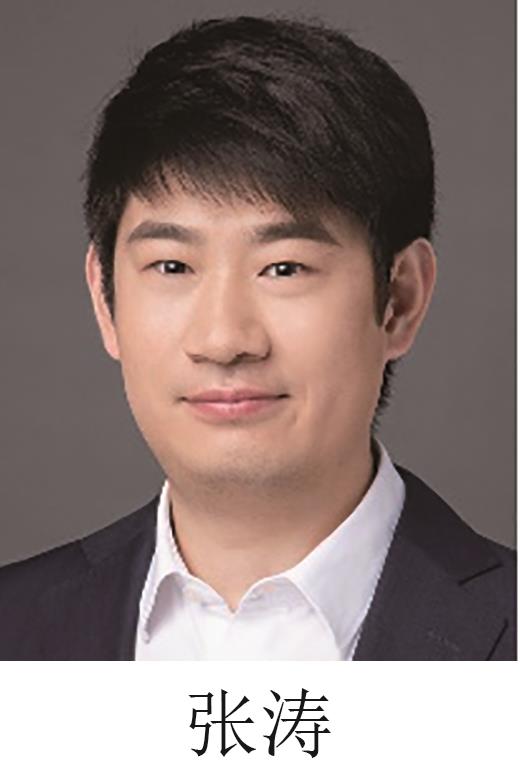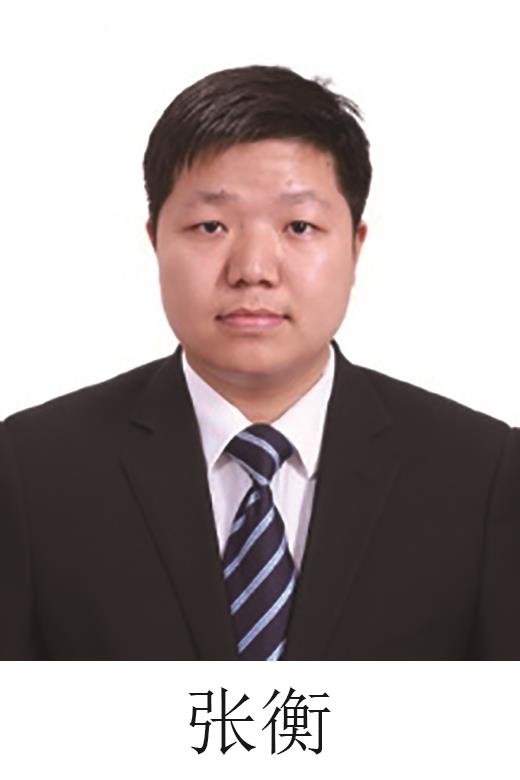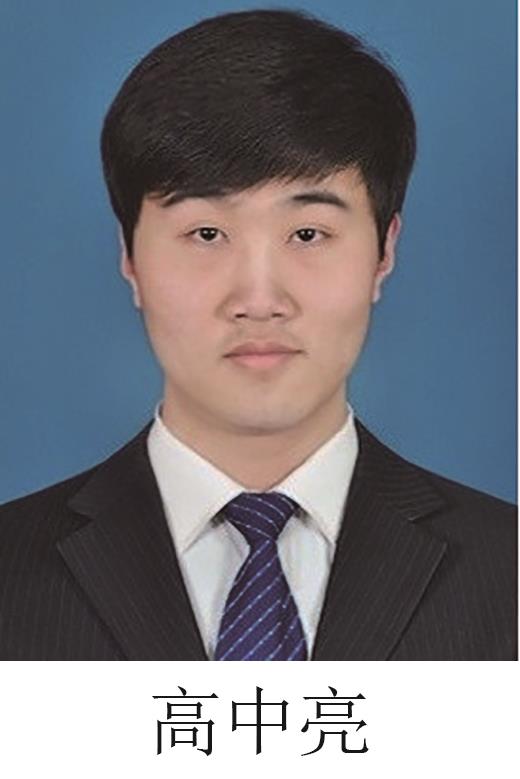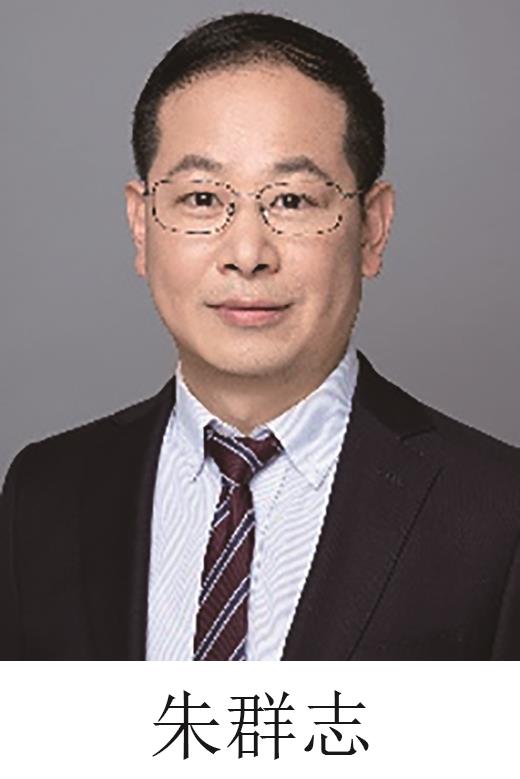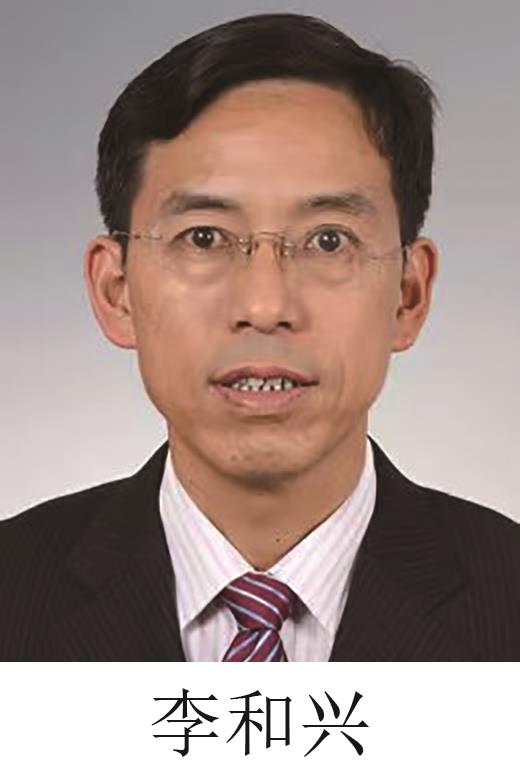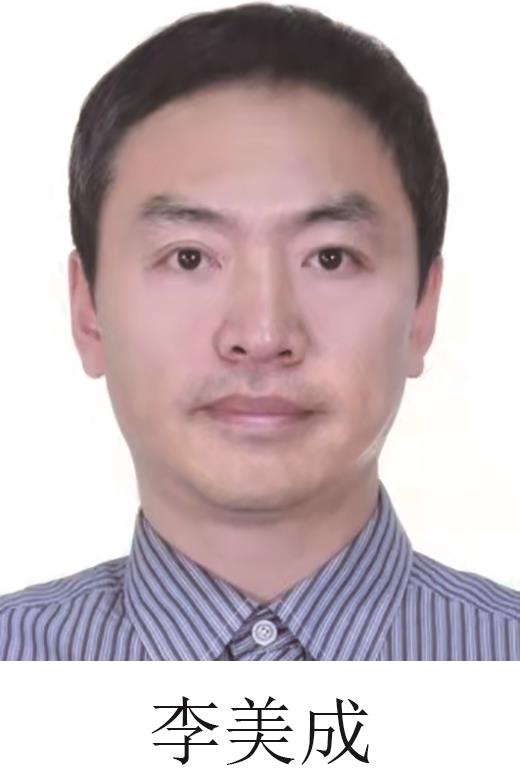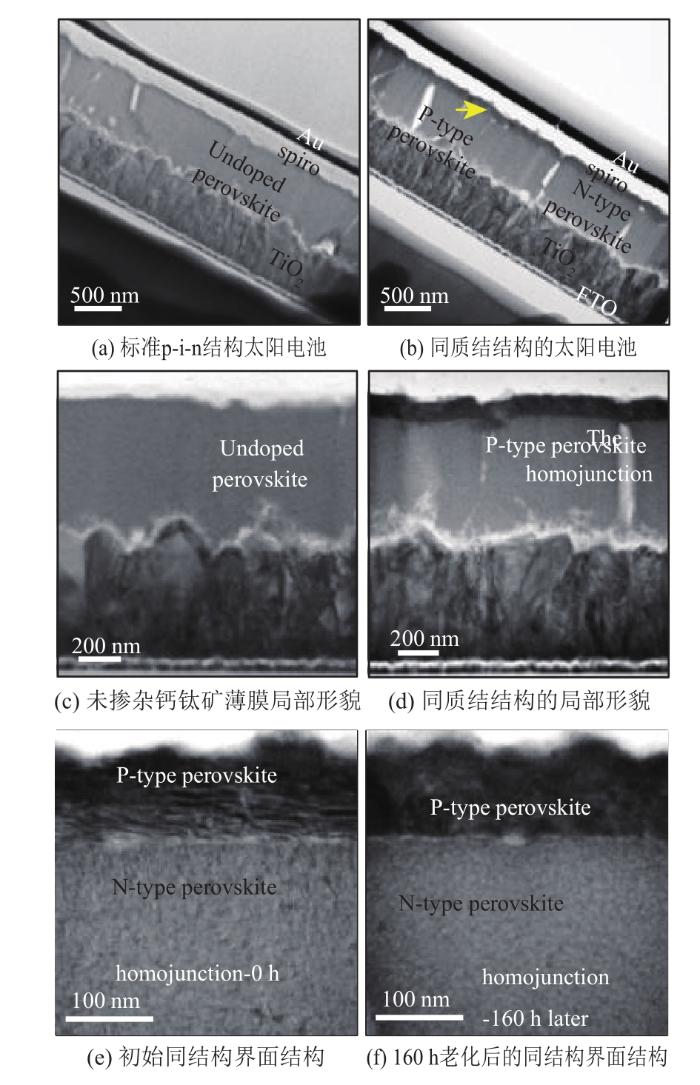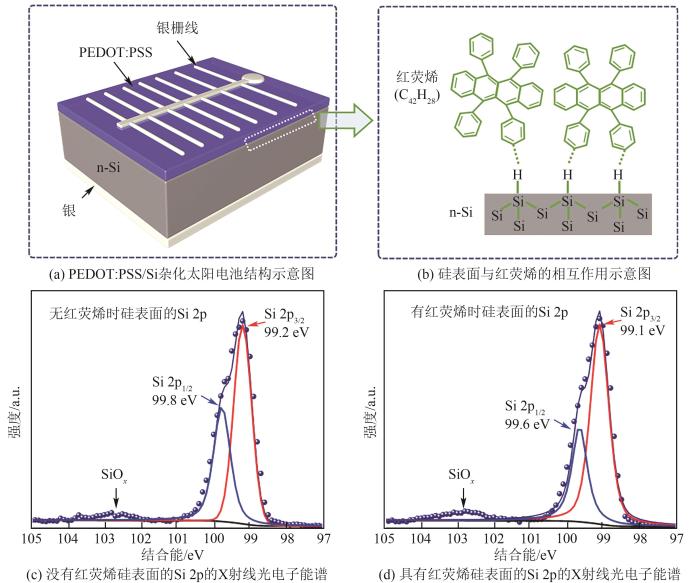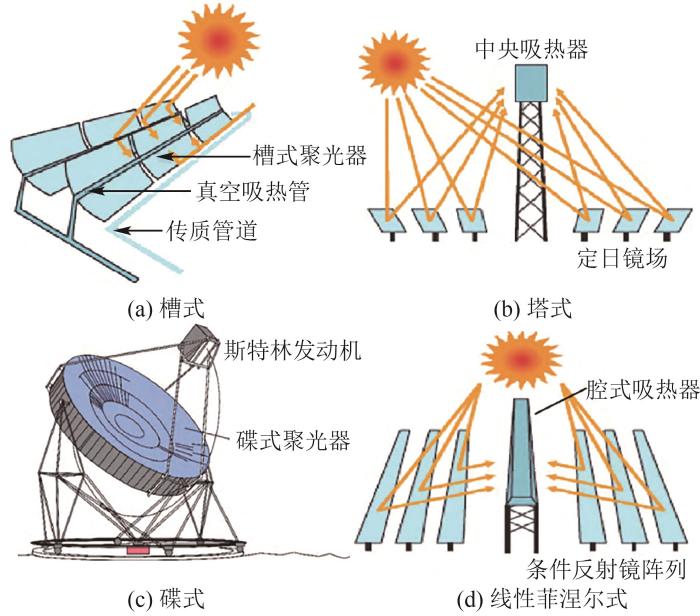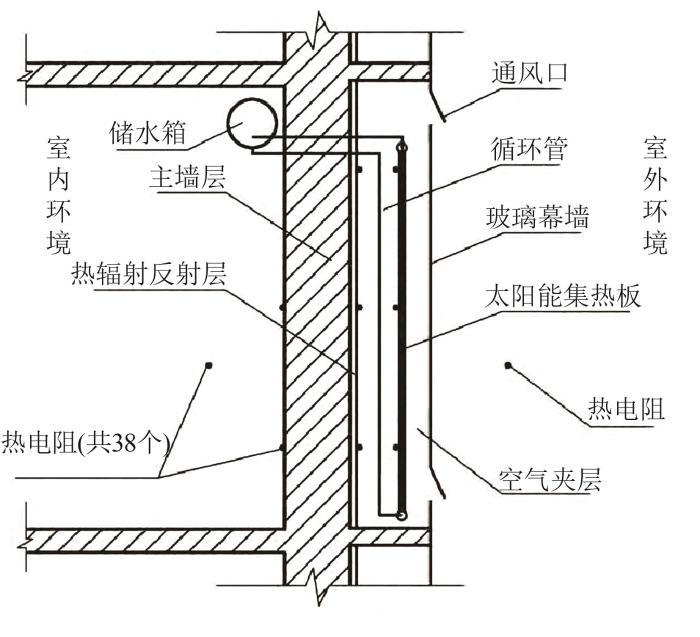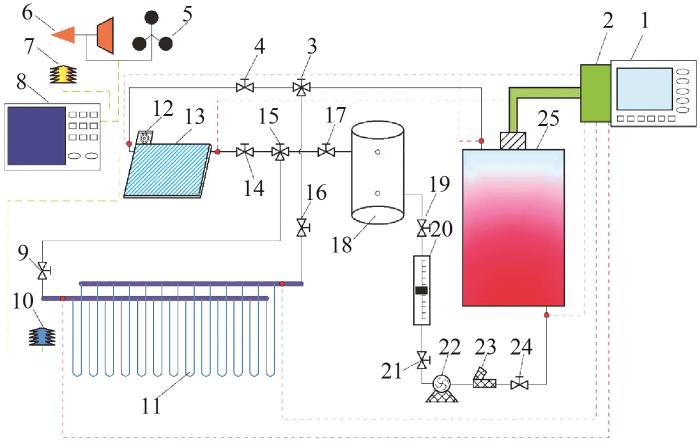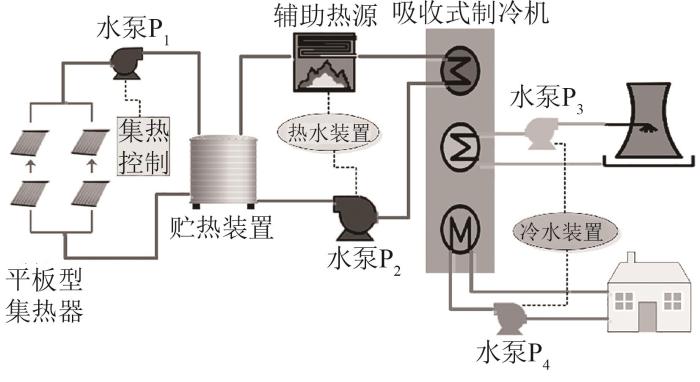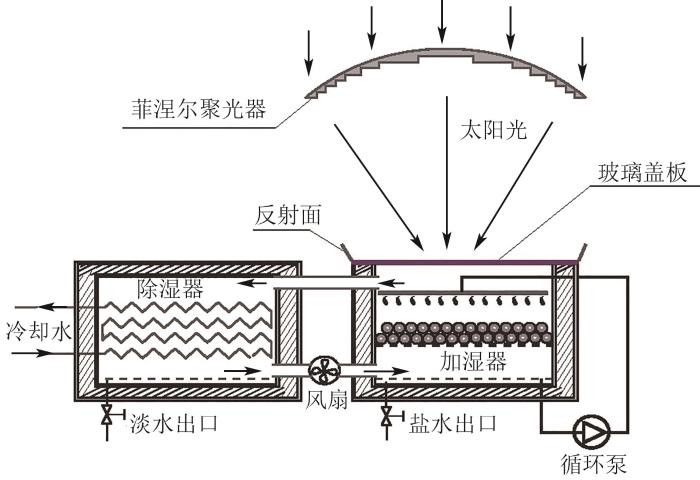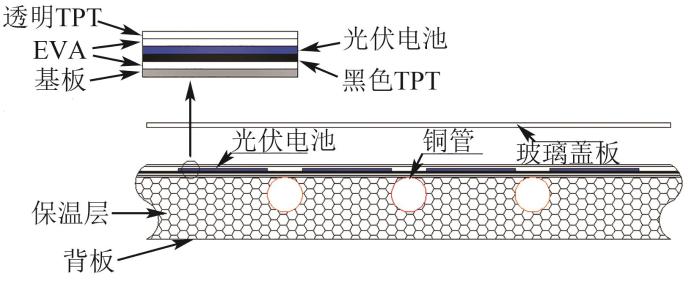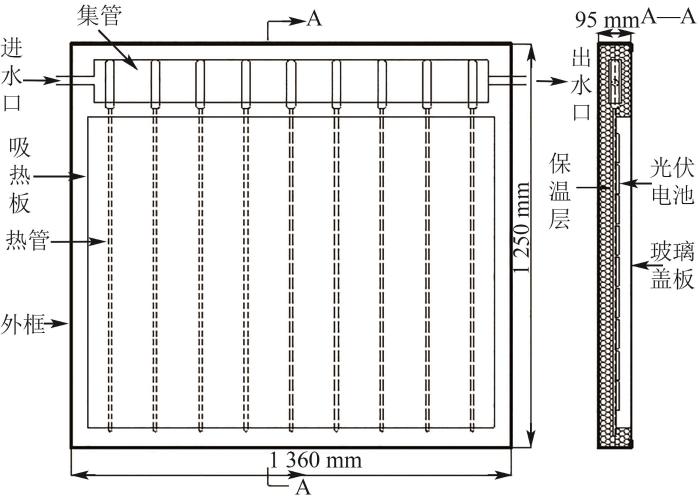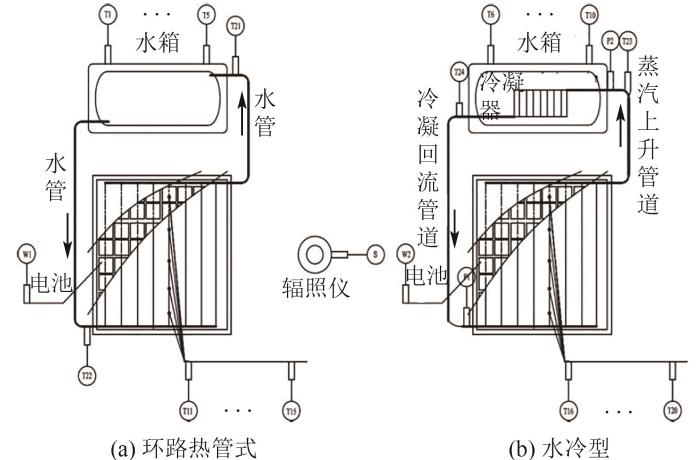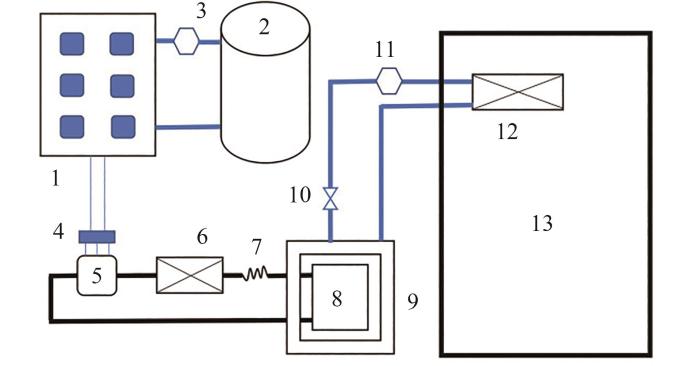0 引言
太阳能光热利用指通过集热器将太阳辐射能转换成热能加以利用,其通常采用聚光装置提高工质温度、提升能量品位、拓宽应用范围。根据工作温度不同,太阳能光热利用可分为低温利用(<100 ℃)、中温利用(100~250 ℃)和高温利用(>250 ℃)。其中,太阳能低温热应用主要用于民用供暖、建筑采暖、生活热水等领域,中温利用主要应用于海水淡化和工业用热领域,高温利用主要是太阳能光热发电[6]。
光伏转换和光热转换技术各具有不同的特征。光伏发电技术价格较低,但受限于太阳辐照的不稳定性和间歇性,光伏发电大规模并网将会给电网带来很大冲击[7]。光热转换技术可采用大规模储热,常规设备与传统火电相同,并且可以直接输出高电能质量的交流电,与电网匹配性较好,但成本较高。光伏发电和光热发电在技术层面却具有很强的互补性。另外,光伏和光热技术相结合有助于降低发电成本,系统高效地利用太阳能资源。因此,太阳能光伏光热一体化(photovoltaic/thermal,PV/T)技术日益受到重视。
太阳能光伏光热一体化技术是将太阳能光伏发电技术与太阳能集热技术有机结合。Kern等[8]最早提出了PV/T的思想,即在光伏组件的背面铺设流道,通过流体带走耗散热能,并对这部分热能加以收集利用。一方面,提高了单位辐照接收面积上的太阳能利用效率;另一方面,通过流体冷却,降低光伏电池温度,提高其光-电效率。PV/T可同时获得电能和热能,具有较高的综合利用效率,是近几年太阳能利用的研究热点之一。目前对PV/T的研究集中于光伏模块与光热模块的集成或层压工艺、冷却介质、流道结构、集热器结构等方面的设计及优化。
此外,将太阳能发电与现代农业、渔业等领域相结合就构成的“光伏+”模式,为太阳能的综合利用提供了一条新的发展道路,不仅可以解决太阳能能量密度低的局限性,还可以有效利用土地和水面资源。
本文对太阳能的光伏、光热、光伏光热一体化综合利用技术现状和优缺点进行了较为详细的分析、总结,同时,简要介绍了“光伏+”模式的发展现状,以期为太阳能高效综合利用技术的发展和推广提供参考。
1 光伏发电技术
光伏发电技术指利用太阳电池将太阳辐射直接转化为电能的技术。太阳电池是光伏发电技术的重要载体。目前,市场占有率最高的是晶硅太阳电池,市场占比超过90%;最具生命力的是钙钛矿太阳电池,2022年2月15日全球首个钙钛矿集中式光伏电站在衢州市开工。此外,由于硅材料出色的稳定性,以及柔性硅的发现,新型硅基太阳电池近年来也备受关注。
1.1 晶硅太阳电池技术
单晶硅太阳电池发展最早,技术也最成熟。由于晶硅制造成本的下降和高效晶硅组件的成熟,自2017年单晶硅太阳电池的市场占有率超过多晶硅太阳电池,占到49%;目前,单晶硅太阳电池的市场占有率已经超过70%。单晶硅太阳电池技术的主要发展趋势是从P型晶硅电池向N型晶硅电池过渡。
1.1.1 P型晶硅太阳电池技术
目前,市场上最主流的太阳电池仍然是P型的发射极及背面钝化电池(passivated emitter and rear cells,PERC)。PERC电池于2016年开始量产;目前,商业化尺寸PERC电池的最高效率可达24.06%。
然而,PERC电池的平均量产效率为22%~22.4%,明显低于N型晶硅电池;PERC电池的双面率仅有75%左右,而N型电池的效率可以达到85%以上;P型晶硅电池的温度系数高于N型晶硅太阳电池;P型晶硅电池的弱光性能比N型电池差;并且P型晶硅电池还存在较为明显的光致衰减效应。
1.1.2 N型晶硅太阳电池技术
N型晶硅太阳电池技术主要包括背接触电池(interdigitated back contact,IBC)、异质结电池(heterojunction with intrinsic thin-layer,HIT)和隧穿氧化层钝化接触电池(tunnel oxide passivated contact solar cell,TOPCon) 3种。
IBC电池是Sunbackower公司于2015年提出的一种电池技术,由于正面没有焊带遮挡,IBC电池能实现最大化的短路电流。2020年,德国能源研究所制备出了效率为26.6%的IBC电池,短路电流密度达到了42 mA/cm2[9]。
HIT电池是Panasonic公司于2015年开发的电池技术,可以大幅提升电池的填充因子。2021年10月隆基在M6全尺寸单晶硅片上创造了26.3%的HIT电池转换效率,填充因子达到了86.59%[10]。HIT电池的平均量产效率可以达到23%~23.6%。
目前,复杂的制备工艺和成本是制约IBC、HIT和TOPCon电池发展的关键因素。根据中国光伏行业协会预测,PERC电池在未来5年将仍保有最高的市场占有率;而TOPCon、HIT和IBC电池的市场份额将逐年增加。长期来看,HIT电池代表了未来晶硅太阳电池技术的发展方向。
1.2 钙钛矿太阳电池
1.2.1 钙钛矿太阳电池性能提升
图1
图1
钙钛矿同质结结构的截面透射电镜表征
Fig. 1
Transmission electron microscope characterization of the cross-sections of perovskite homojunction
1.2.2 钙钛矿太阳电池稳定性提升
未来,高效稳定的钙钛矿太阳电池迈向大规模生产应用还将向着大面积组件制备、绿色生产、防止铅泄漏等方向发展。
1.3 新型硅基太阳电池
当硅片厚度小于20 μm时具有非常好的机械柔性。新型硅基柔性太阳电池引起了人们广泛的研究兴趣。其中,以PEDOT:PSS(聚3, 4-乙烯二氧噻吩/聚苯乙烯磺酸盐)为空穴传输层的PEDOT:PSS/Si杂化电池的研究最为广泛。然而,硅的光吸收系数较低,超薄硅片难以实现对太阳光的充分吸收。通过光管理技术解耦太阳电池的光电性能与厚度的关联,实现充分的光吸收,对提升超薄硅基杂化太阳电池的效率具有决定性作用。
1.3.1 光管理
硅纳米线结构可以大幅增强太阳电池的光吸收[44-46]。通过对硅纳米线的光管理特性的系统研究发现,其响应波长取决于直径,光捕获能力则与其长度成正比[47];并拟合出了可描述硅纳米线长度、直径与响应光谱之间关系的解析方程[48]。通过探究环境对硅纳米线光学性能的影响,发现硅纳米线在PEDOT:PSS中(折射率1.284)的本征吸收变小,有利于陷光增强[49];硅纳米线的表面氧化硅层将使光更容易传递至硅衬底中[50]。圆柱形硅纳米线往往只有一个响应峰,因而仅能实现某一波段的光吸收增强。为此,研究人员探讨了锥形硅纳米线的光谱响应特性,发现锥形硅纳米线具有多个光谱响应峰,可以实现宽光谱的陷光增强[51];设计了三叶形硅纳米线,如图2所示,可以在拓宽响应光谱的同时保证响应光谱的强度[52]。此外,还可以设计硅-银复合结构,以实现金属和半导体纳米结构的协同陷光增强[53-55]。
图2
图2
三叶形硅纳米线结构示意图及光学性能
Fig. 2
Structural diagram and optical properties of trilobal silicon nanowires
1.3.2 PEDOT:PSS/Si杂化太阳电池
使用将加入乙二醇的PEDOT:PSS溶液加热后再加入表面活性剂的方式,结果发现PEDOT:PSS会出现相的分离与胶联[63]。PEDOT相重新胶联成高效的导电网络,且使得该溶液旋涂成膜后PEDOT:PSS的功函数从4.5 eV 提升至4.8 eV。采用该方法对PEDOT:PSS进行溶液改性,使PEDOT:PSS/Si杂化太阳电池的转换效率从11.03%提高至12.38%。
图3
图3
PEDOT:PSS/Si杂化太阳电池中硅表面与红荧烯的相互作用机制
Fig. 3
Interaction mechanism between silicon surface and rubrene in PEDOT:PSS/Si solar cells
窗口层对PEDOT:PSS/Si杂化太阳电池的光吸收的影响非常重要。通过调控PEDOT:PSS薄膜的厚度发现,PEDOT:PSS层的最佳厚度为90 nm左右,按此制备的太阳电池器件效率达到了12.35%[66]。
超薄硅表面的应力会因为表面微纳结构而集中,难以实现高效率和柔韧性兼容。为此,对超薄硅太阳电池的力学、光学和电学性进行了耦合仿真研究[67]。结果表明柔性PDMS薄膜陷光结构可以同时提升器件的光吸收和柔韧性:表面应力降低33.4%,光吸收提升42.3%,器件转换效率从6.86%提升到9.76%。
除了转换效率,机械柔性、稳定性和大面积制备也将是决定PEDOT:PSS/Si杂化太阳电池是否具有实用价值的关键。因此,亟需开展PEDOT:PSS/Si杂化太阳电池的力学性能、稳定性和制备技术方面的研究工作。
2 光热技术
太阳能光热技术应用领域较为广泛,在高、中、低温相关领域都有不同程度的发展。其中太阳能热发电、太阳能建筑采暖与制冷、太阳能热法海水淡化,以及太阳能工业热利用等技术具有良好应用前景。
2.1 太阳能热发电
图4
表1 4种光热发电技术比较
Tab. 1
| 参数 | 槽式 | 塔式 | 碟式 | 线性菲涅尔式 |
|---|---|---|---|---|
| 规模/MW | 10~350 | 10~150 | 0.01~1 | 10~320 |
| 成熟度 | 商业化 | 商业化 | 示范 | 示范 |
| 聚光方式 | 线聚焦 | 点聚焦 | 点聚焦 | 线聚焦 |
| 跟踪方式 | 单轴追踪 | 双轴追踪 | 双轴追踪 | 单轴追踪 |
| 聚光比 | 10~100 | 300~1 500 | 1 000~3 000 | 35~170 |
| 传热介质 | 水/蒸汽、熔盐、导热油、空气 | 水/蒸汽、熔盐 | 氢、熔盐 | 水/蒸汽、熔盐 |
| 运行温度/℃ | 150~550 | 300~1 200 | 300~1 500 | 150~400 |
| 峰值效率/% | 21 | 23 | 29.4 | 20 |
| 热发电效率/% | 10~16 | 10~22 | 16~29 | 8~12 |
| 单位造价/(美元/W) | 2.7~4.0 | 2.5~4.4 | 1.3~12.6 | 5.4 |
| 发电成本/[美元/(kW∙h)] | 0.13~0.26 | 0.08~0.16 | 0.25 | 0.28 |
槽式和塔式是当前较为主流的2种光热发电技术,其中槽式热发电技术已经趋于成熟,塔式热发电技术发展迅速,均已在商业上获得成功应用。美国加利福尼亚早在1991年建设了全球首座商业化SEGS槽式光热电站,总装机容量达到354 MW[72]。西班牙在2007年建设了欧洲第一座商业化塔式热电站PS10,设计功率为11 MW,随后在2012年建成了世界最大的线性菲涅尔式电站PuertoErrado,装机容量为30 MW,运行温度达到270 ℃[73]。近年来,我国的热发电技术也取得了巨大进展。2012年我国在八达岭建成了国内首个、亚洲最大的塔式热发电示范电站,此后,德令哈50 MW导热油槽式、敦煌100 MW熔盐塔式、敦煌50 MW熔盐线性菲涅尔式等光热示范电站相继投产。截至2021年年底,我国太阳能热发电累计装机容量为538 MW(含兆瓦级以上规模的发电系统),其中,塔式、槽式和线性菲涅尔式技术路线占比分别为60%、28%和12%[74]。
基于蒸汽朗肯循环的光热发电技术成熟,是当前商业应用的主流方向。但这类系统存在聚光集热面积大、循环温度较低、效率较低等问题,阻碍了自身快速发展[75]。超临界CO2布雷顿循环所需的温度范围与塔式集热装置的集热温度相契合,具有进一步提升太阳能热发电效率的潜力。
2.2 太阳能建筑采暖与制冷
建筑能耗在总能耗中占据较大比例,而建筑能耗结构中2/3的能源用于建筑采暖、制冷和热水供应。因此,充分利用太阳能进行采暖、降温和热水供应是实现建筑节能的一个有效途径[88]。太阳能光热技术在建筑采暖应用领域可分为“被动式”利用技术和“主动式”利用技术。
2.2.1 太阳能建筑被动采暖系统
图5
2.2.2 太阳能建筑主动采暖系统
图6
图6
储热型太阳能供暖系统原理图
1—TP700数据采集器;2—K型点状测温传感器;3—三通阀-1;4—球阀-1;5—风速仪;6—风向标;7—环境温度传感器(室外);8—CR3000数据采集器;9—球阀-2;10—环境温度传感器(室内);11—毛细管网;12—倾斜面太阳总辐射表;13—平板热管型太阳能集热器;14—球阀-3;15—三通阀-2;16—球阀-4;17—球阀-5;18—缓冲水箱;19—球阀-6;20—玻璃浮子流量计;21—球阀-7;22—循环泵;23—Y型过滤器;24—球阀-8;25—相变储热单元。
Fig. 6
Schematic diagram of solar heating system with heat storage
图7
图7
小型太阳能吸收式制冷系统结构图
Fig. 7
Schematic diagram of small solar absorption refrigeration system
2.3 太阳能热法海水淡化
太阳能海水淡化技术分为热法与膜法两大类。利用太阳能产热加热海水,经浓缩蒸发冷凝后产出淡水的过程称之为热法;利用太阳能发电驱使海水无相变地通过半透膜实现淡化过程,称之为膜法。太阳能热法海水淡化技术又可分为直接法和间接法两大类:直接法即直接利用太阳能在集热器中对海水进行蒸馏;间接法中太阳能集热器和海水蒸馏装置是分开的,其中一个用来收集太阳能,另一个用来对海水进行脱盐[93]。典型的热法太阳能海水淡化方法包括太阳能多级闪蒸、太阳能多效蒸馏、太阳能增湿除湿、太阳能膜蒸馏等。我国首个太阳能海水淡化示范项目采用菲涅尔式聚光集热系统加热产出170 ℃热蒸汽作为热源,每年可产出2 000 t淡水。
图8
图8
太阳能增湿除湿海水淡化系统示意图
Fig. 8
Schematic diagram of humidified-dehumidified solar water desalination system
2.4 太阳能工业热利用
中温太阳能集热器的运行温度一般在90 ℃以上,最高可达350 ℃,产生的高温热水或者低温低压蒸汽可用于多种工业应用场景。太阳能工业热利用主要有2种型式,适用于许多工业部门。因此该系统通常含有2种型式:一是采用集热器直接将工质加热至所需温度;二是将太阳能系统与锅炉系统实现热力集成,冷水经太阳能预热(加热至95 ℃)后,送至锅炉系统加热至特定温度的蒸汽,进而使用。工业热利用领域为获得温度较高的热水或蒸汽,通常利用聚光技术来提高热能品质,常用聚光技术有复合抛物面集热器(compound parabolic collector,CPC)与槽式面聚光集热器,一般不采用高温点聚光集热器和平板集热器。研究人员设计了一种低截取比的CPC空气集热器,发现集热器最大出口温度可达200 ℃,低截取比的CPC聚光器可有效减少材料消耗[96]。在实际工程应用中,力诺瑞特研发的U形管式CPC中温集热器产品,与锅炉进行热力集成后,可以将冷水经太阳能集热器预热后由锅炉加热成150 ℃的蒸汽供工业应用。
3 光伏光热一体化技术
3.1 典型PV/T集热器结构
PV/T的研究前期集中于以水和空气作为冷却介质。文献[97-98]通过理论研究指出,PV/T 系统的光电/光热综合效率可以达到60%~80%,明显高于单独的光-电系统或光-热系统。文献[99]对光伏/热水、光伏/热空气以及有无玻璃盖板、有无聚光板的PV/T系统性能进行了对比研究,并对不同的PV/T系统的全年运行性能及经济性进行计算和分析,结果表明,PV/T可以提高系统的经济可行性,具有更好的成本/效益比。另外,关于常规PV/T更多的研究进展及研究结论可参考文献[100-101]。其中,有研究[102]发现,以水为冷却介质可获得比以空气为冷却介质更好的电池冷却效果及更高的综合利用效率,其典型结构如图9所示。
图9
传统的水冷型PV/T系统在高纬度或是冬季结冰的地区使用时,铜管内的水易冻结,从而对管道造成损害,管道的变形会进一步引起电池板芯形变,从而造成光伏电池的损坏。此外,由于水冷型PV/T系统中冷却水直接与管道(铜管或是不锈钢管等)接触,会造成管道的腐蚀,降低其使用寿命。引入重力或环路热管与热泵技术、利用相变蓄热等措施可有效提升传统PV/T系统性能,克服水冷型PV/T的缺点。
3.2 重力热管式PV/T集热器
图10
图10
重力热管式PV/T集热器(集管式冷却)
Fig. 10
Gravity heat pipe type PV/T collector (header type cooling)
图11
图11
重力热管式PV/T集热器(套管式冷却)
Fig. 11
Gravity heat pipe type PV/T collector (drivepipe type cooling)
3.2.1 重力热管式PV/T实验研究
3.2.2 重力热管式PV/T理论研究
文献[105-107]基于分布参数法建立了重力热管式PV/T系统的数学模型,对结构及运行参数对系统综合性能的影响进行了敏感性分析,结果表明:光热和光电效率随质量流量、热管冷凝端截面直径和热管数量的增加而增加,随集管宽度的增加而降低;系统电增益和PV/T效率随光伏电池覆盖率的增加而增加,提高光伏覆盖率有利于提高太阳辐射利用率,从而提高能量输出品质。针对热管工质,温暖气候区建议采用水,而寒冷气候区建议采用R134a。Pei等[108]基于典型气象数据对热管式PV/T的年运行收益进行了评估,结果表明:系统获得的有效热能和电能主要依赖该地区的可用太阳辐射;对于北京地区,系统全年获得总热量和总光电输出分别为8 165.62~9 101.21 MJ和1 248.75~1 269.28 MJ,全年平均太阳能-热能贡献率为46.6%~64.7%。Zhang等[109]通过进一步研究表明:热管式PV/T系统由于热二极管特性,其夜间损失较小,有效供热天数更多,光热性能较好,但光电性能差别不大;同时,相对设定终温和光伏覆盖率,水箱容积对综合收益的影响更大。
重力热管工作的最佳倾角与PV/T的最佳倾角不匹配,研究人员[110]进一步建立了倾斜热管的三维数学模型,探究了倾角对热管式PV/T系统综合性能的影响。结果表明:倾斜状态下液膜厚度在大部分长度上都是稳定的;冷凝端相对薄膜热阻随倾角的增大先减小后增大,而蒸发端与冷凝端的薄膜热阻呈现相反的变化趋势;热管的总热阻主要由蒸发端决定,而蒸发端的热阻主要由液池的有效高度决定。实验和模拟结果均表明,倾角为40°时系统性能最好。
3.3 环路热管式PV/T集热器
重力热管的蒸发端和冷凝端位置相对固定,与PV/T技术结合时存在诸多限制。环路热管的蒸发端和冷凝端分离的特性使其更易与PV/T利用相结合。Pei等[111-112]设计搭建了环路热管式PV/T系统与传统水冷型PV/T系统的对比实验测试平台,如图12所示。实验结果表明:环路热管式PV/T系统具有更好的温度均匀性,进而导致较高的光电效率,但由于二次换热,其光热性能略差;虽然实验期间二者光-电、光-热效率不同,但它们的㶲效率几乎一致。二者典型光热光电综合效率的拟合曲线也从侧面证实了上述结论,且长期运行性能拟合结果表明,环路热管式PV/T系统具有更高的典型热效率和典型光热综合效率,同时具有较大的热损系数。
图12
图12
环路热管式及水冷型PV/T对比测试平台
Fig. 12
Comparison setup of loop thermosyphon type and water cooled PV/T collectors
3.4 光伏-太阳能热泵系统
热泵的低温蒸发吸热与PV/T利用相结合,可同时实现光伏电池的低温冷却及热能的高温输出;与空气源热泵结合时还可克服太阳能的间歇性。基于PV/T的热泵供暖制冷系统如图13所示。
图13
图13
基于PV/T的热泵供暖制冷系统
1—PV/T集热器;2—水箱;3—水泵;4—控制器;5—压缩机;6—冷凝器;7—毛细管;8—蒸发器;9—蓄冰槽;10—阀门;11—泵;12—风机盘管;13—室内。
Fig. 13
Schematic diagram of the PV/T refrigeration/heating system
Cai等[118]将PV/T集热器与空气换热器并联同时作为热泵系统的蒸发器,提出了空气源-太阳能复合热源热泵系统,对工质在蒸发侧的迁移分布规律进行了理论研究。结果表明,复合热源能够弥补单一热源在低蒸发温度和高冷凝温度等不利工况下运行时的缺陷,有效提高系统的运行性能和稳定性。为满足建筑的多种能量需求,Cai等[119-121]进一步将复合热源热泵技术与多功能热泵技术有机结合,提出太阳能-空气源复合热源多功能热泵系统,研究了电子膨胀阀开度、环境温度以及太阳辐照强度等关键因素对系统性能的影响规律,并对系统在秋季和冬季气象条件下的动态运行性能进行了户外实测,初步探讨了系统的夜间制冷性能,结果表明,PV/T双源热泵系统在各种工况下都能稳定运行,且在节能和性能改善方面更为有效。
3.5 含相变材料蓄热的PV/T系统
针对在电池背部设置换热通道的平板型PV/T,采用含相变材料(phase change material,PCM)的多层结构PV/T系统来提升性能[122]。多层结构PV/T系统是将PCM层置于PV背板与换热通道之间,通过蓄热作用调节光伏电池的温度,夜间还能释放热量,用于管路系统冬季防冻,明显提高传统PV/T系统[123]的发电、产热效率及工作可靠性。研究发现,在上海地区秋季典型测试条件下,利用多层结构PV/T系统的平均电效率可提高近1%,综合效率可提高25.2%。采用类似PCM多层结构的PV/T系统亦获得了较高的电热效率。这些研究为相变材料在传统PV/T系统中的应用提供了一个值得深入拓展的方向,可围绕相变材料的选择、应用位置、布置方式、导热强化等方面展开。
4 “光伏+”太阳能综合利用
随着太阳电池组件技术日渐成熟,其应用场景从大型光伏电站延伸到更多方面,衍生了包括“光伏+”建筑、基建、农业和交通等多种分布式太阳能综合利用的方式。
4.1 “光伏+”建筑
BIPV虽然在多方面更具优势,但需要承担被替代的传统建筑材料的功能,更换现有建筑的玻璃、屋顶会造成很大影响,所以,现阶段依旧以BAPV为主,后期随着新建建筑的出现,BIPV的占比会逐渐提高,其发展潜力巨大。
4.2 “光伏+”基建
“光伏+”基建指的是光伏组件与基础设施的结合。例如,将光伏组件作为路灯、道路警示牌的电源,光伏智能公路等。光伏智能公路中组件产生的电能可以为公路旁的路灯和指示灯提供能源补给,剩余的电能可以传输到电网。
新能源汽车的蓬勃发展为光伏提供了新的“光伏+基建”应用场景[129]。在充电桩附近的停车区域设置光伏遮阳棚,将光伏电池配上充放电控制装置及蓄电池,就能在为汽车遮蔽风雨的同时实现新能源汽车的零碳排放。
随着5G通信技术的发展,“站点式光伏+5G”的“光伏+基建”具有灵活、方便、高效、节能等优势,应用潜力巨大。5G信号的发送及传输需要消耗巨大的电能,站点式光伏发电站能够在很大程度上为5G基站补充电能消耗。同时,5G智能也可以用于站点式光伏,满足光伏电站的实时数据采集和传输、远程调度与协调控制、多系统高速互联等功能,实现电站的实时监测和智能运维。“光伏+5G”模式既符合当下数字化经济的提议,又十分契合中国“双碳”目标重大决议,未来定会有很好的发展。
4.3 “光伏+”农业
“光伏+”农业指光伏与大棚、畜牧业和渔业等的结合。光伏大棚是在普通大棚的顶部安装薄膜太阳电池板,将太阳辐射分为植物需要的光能和光伏发电的光能,既满足了植物生长的需要,又实现了光电转换。光伏畜牧则主要利用光伏电池和蓄电池为无电区牧民提供基本生活供电。
光伏渔业是在水面上安装漂浮式光伏形成“上发电下养殖”的新型节能农业模式。这一模式存在一些问题:1)水面遮光导致鱼塘水生植物产氧量下降;2)光伏组件安装和绝缘要求更高;3)组件腐蚀更加严重。这一模式的未来发展应着力于寻求最佳安装面积,解决绝缘、腐蚀问题,使渔业和光伏结合,为渔民带来最大创收。
5 结论
针对光伏发电技术、光热技术、光热一体化和“光伏+”4种太阳能利用技术进行了综述。介绍了各种太阳能利用技术的优缺点、原理、技术分类和现存问题,并对它们的发展前景和技术发展趋势进行了展望。
1)光伏发电技术是解决未来能源需求问题最有前途的技术之一。晶硅太阳电池正在从P型向更高效率的N型电池转变,其中,HIT电池代表了未来晶硅太阳电池技术的发展方向。稳定性是制约钙钛矿太阳电池开启商业化进程的主要瓶颈;除此之外,还亟需开发钙钛矿组件的大面积制备工艺。新型硅基杂化太阳电池的研究目前仍集中在获得高转换效率上;针对其力学性能、稳定性和制备工艺开展研究,有望成为未来一段时间的热点。
2)光热发电具备灵活性调节优势,能够为高比例可再生能源并网情境下电网快速调峰调频奠定安全稳定的基础;高效率、大容量、高聚光比的光热发电技术是未来主要研究方向。太阳能建筑采暖与制冷技术是降低建筑中传统能源消耗、提高工业加热清洁化的有效途径与方法,能为区域能源供给提供新的思路。太阳能热法海水淡化技术可以独立运行且具有不消耗常规能源、环保等优势,大幅提高清洁能源使用比例,同样具备较好的发展前景。
3)PV/T技术具备更好的综合性能及建筑节能潜力,特别是与空气源热泵结合可实现全天候工作。目前的研究集中在引入重力或环路热管、热泵技术、相变蓄热措施等提升PV/T系统的性能;PV/T技术未来需着力于集热器集成工艺与综合效率及使用寿命的提升及改进。
4)“光伏+”模式的探索更使得新型的太阳能利用技术与传统的农业、建筑和基建等领域灵活紧密地结合起来,进一步提高了太阳能综合利用的效率和灵活性。其中,BIPV、“光伏+充电桩”“光伏+5G”、光伏大棚等技术均具有巨大的发展潜力。
参考文献
High-resolution data shows China’s wind and solar energy resources are enough to support a 2050 decarbonized electricity system
[J].
Solar energy potential assessment: a framework to integrate geographic,technological, and economic indices for a potential analysis
[J].
能源转型展望2018
[EB/OL].(
Energy transition outlook 2018
[EB/OL].(
World energy outlook 2018
[R].
太阳能光热利用浅析
[J].
A brief analysis of solar thermal utilization
[J].
关于降低大规模光伏发电对电力系统影响的研究
[J].
Research on reducing the impact of large-scale photovoltaic power generation on the power system
[J].
Combined photovoltaic and thermal hybrid collector systems
[C]//
Transparent silicon carbide/tunnel SiO2 passivation for c‐Si solar cell front side:enabling Jsc> 42 mA/cm2 and iVoc of 742 mV
[J].
%!隆基一周两破HJT电池效率世界纪录
[EB/OL].(
%!Longji broke HJT battery efficiency world record twice a week
[EB/OL].(
A passivated rear contact for high-efficiency n-type silicon solar cells enabling high Vocs and FF> 82
%[C]//
Design rules for high-efficiency both-sides-contacted silicon solar cells with balanced charge carrier transport and recombination losses
[J].
Organometal halide perovskites as visible-light sensitizers for photovoltaic cells
[J].
Pseudo-halide anion engineering for alpha-FAPbI3 perovskite solar cells
[J].
Efficient perovskite solar cells via improved carrier management
[J].
Research direction toward scalable, stable,and high efficiency perovskite solar cells
[J].
Silk fibroin induced homeotropic alignment of perovskite crystals toward high efficiency and stability
[J].
Over 21% efficiency stable 2D perovskite solar cells
[J].
Photo-induced degradation of lead halide perovskite solar cells caused by the hole transport layer/metal electrode interface
[J].
Low-dimensional inorganic tin perovskite solar cells prepared by templated growth
[J].
Efficiency enhancement with the ferroelectric coupling effect using P(VDF-TrFE) in CH3NH3PbI3 solar cells
[J].
A TiO2 embedded structure for perovskite solar cells with anomalous grain growth and effective electron extraction
[J].
Highly efficient electron-selective layer free perovskite solar cells by constructing effective p-n heterojunction
[J].
Planar p-n homojunction perovskite solar cells with efficiency exceeding 21.3%
[J].
Managing carrier lifetime and doping property of lead halide perovskite by postannealing processes for highly efficient perovskite solar cells
[J].
TiO2 surface oxygen vacancy passivation towards mitigated interfacial lattice distortion and efficient perovskite solar cell
[J].
Perovskite solar cells with atomically coherent interlayers on SnO2 electrodes
[J].
Facet orientation tailoring via 2D-seed-induced growth enables highly efficient and stable perovskite solar cells
[J].
UV light absorbers executing synergistic effects of passivating defects and improving photostability for efficient perovskite photovoltaics
[J].
Development of encapsulation strategies towards the commercialization of perovskite solar cells
[J].
Degradation of organometallic perovskite solar cells induced by trap states
[J].
Intact 2D/3D halide junction perovskite solar cells via solid-phase in-plane growth
[J].
Omnibearing interpretation of external ions passivated ion migration in mixed halide perovskites
[J].
Stabilized tilted-octahedra halide perovskites inhibit local formation of performance-limiting phases
[J].
General decomposition pathway of organic-inorganic hybrid perovskites through an intermediate superstructure and its suppression mechanism
[J].
Moisture-tolerant supermolecule for the stability enhancement of organic-inorganic perovskite solar cells in ambient air
[J].
Metastable dion-jacobson 2D structure enables efficient and stable perovskite solar cells
[J].
Revealing the strain-associated physical mechanisms impacting the performance and stability of perovskite solar cells
[J].
Monolithic perovskite/organic tandem solar cells with 23.6% efficiency enabled by reduced voltage losses and optimized interconnecting layer
[J].
1 000 h operational lifetime perovskite solar cells by ambient melting encapsulation
[J].
Ion-migration inhibition by the cation-pi interaction in perovskite materials for efficient and stable perovskite solar cells
[J].
Two-stage ultraviolet degradation of perovskite solar cells induced by the Oxygen vacancy-Ti(4+) states
[J].
Single-nanowire solar cells beyond the Shockley-Queisser limit
[J].
n-GaAs/InGaP/p-GaAs core-multishell nanowire diodes for efficient light-to-current conversion
[J].
Coaxial silicon nanowires as solar cells and nanoelectronic power sources
[J].
Linear length-dependent light-harvesting ability of silicon nanowire
[J].
Exact comprehensive equations for the photon management properties of silicon nanowire
[J].
Effects of the ambient medium and structure parameter on the optical properties of tapered silicon nanowire
[J].
Oxidation of silicon nanowire can transport much more light into silicon substrate
[J].
A comparison of light-harvesting performance of silicon nanocones and nanowires for radial-junction solar cells
[J].
Excellent light-capture capability of trilobal SiNW for ultra-high JSC in single-nanowire solar cells
[J].
Specific distribution of the light captured by silver nanowire
[J].
Light harvesting of silicon nanostructure for solar cells application
[J].
Broadband light-concentration with near-surface distribution by silver capped silicon nanowire for high-performance solar cells
[J].
Flexible,polymer-supported,Si wire array photoelectrodes
[J].
Augmentation of absorption channels induced by wave-chaos effects in free-standing nanowire arrays
[J].
Stretchable and colorless freestanding microwire arrays for transparent solar cells with flexibility
[J].
Silicon nanowire design for ultrahigh extinction by dipole near-field interaction in transparent solar cells
[J].
Helical SiNW design with a dual-peak response for broadband scattering in translucent solar cells
[J].
High efficiency (>17%) Si-organic hybrid solar cells by simultaneous structural, electrical, and interfacial engineering via low-temperature processes
[J].
Silicon/organic hybrid solar cells with 16.2% efficiency and improved stability by formation of conformal heterojunction coating and moisture-resistant capping layer
[J].
Phase separation to improve the conductivity and work function of the PEDOT:PSS solution for silicon hybrid solar cells
[J].
Improving junction quality via modifying the Si surface to enhance the performance of PEDOT:PSS/Si hybrid solar cells
[J].
14.1% efficiency hybrid planar-Si/organic heterojunction solar cells with SnO2 insertion layer
[J].
Improving light absorption of active layer by adjusting PEDOT:PSS film for high efficiency Si-based hybrid solar cells
[J].
Moth-eye nanostructure PDMS films for reducing reflection and retaining flexibility in ultra-thin c-Si solar cells
[J].
Progress in research and development of molten chloride salt technology for next generation concentrated solar power plants
[J].
太阳能热利用技术分析与前景展望
[J].
Technology analysis and prospects of solar thermal utilization
[J].
流量对抛物面槽式太阳能集热器传热特性影响的实验分析
[J].
Experimental analysis of the influence of flow rate on heat transfer characteristics of parabolic trough solar collector
[J].
Prospects and problems of concentrating solar power technologies for power generation in the desert regions
[J].
槽式太阳能热发电技术研究现状与发展
[J].
State and trend of solar parabolic trough power generation technology
[J].
A review of concentrating solar power plants in the world and their potential use in Serbia
[J].
2021中国太阳能热发电行业蓝皮书
[R].
2021 China solar thermal power industry blue book
[R].
太阳能与燃煤机组互补电站热力特性与集成机理研究
[D].
Study on thermal performance and integrated mechanism of solar-aided coal fired power plant
[D].
Thermodynamic study of advanced supercritical carbon dioxide power cycles for concentrating solar power systems
[J].
Exergetic analysis of supercritical CO2 Brayton cycles integrated with solar central receivers
[J].
Thermodynamic advantage of using solar energy in the conventional power station
[J].
Solar thermal aided power generation
[J].
Optimization study of integration strategies in solar aided coal-fired power generation system
[J].
Evaluation methods of solar contribution in solar aided coal-fired power generation system
[J].
Analysis of a solar-aided coal-fired power generation system based on thermo-economic structural theory
[J].
Thermal performance of different integration schemes for a solar tower aided coal-fired power system
[J].
Annual performance analysis and optimization of a solar tower aided coal-fired power plant
[J].
Performance analysis of a novel combined solar trough and tower aided coal-fired power generation system
[J].
Research on the performance of solar aided power generation system based on annular fresnel solar concentrator
[J].
光-煤互补复合发电系统优化设计及其热力性能分析
[D].
Analysis on optimization design and thermodynamic performance of solar aided power generation system
[D].
我国被动式太阳能采暖技术的应用现状及发展前景
[J].
Application status and development prospect of passive solar heating technology in China
[J].
光热建筑一体化Trombe墙体系统传热性能
[J].
Heat transfer performance of a photo-thermal trombe wall system integrated with building
[J].
储热型太阳能供暖系统热输送全过程特性研究
[J].
Study on whole process characteristic of heat transfer in solar heating system with heat storage
[J].
北京某农村住宅空气源热泵辅助太阳能供暖系统的运行性能
[J].
Operation performance of air-source heat pump assisted soar heating system in Beijing rural residence
[J].
平板型集热器驱动的小型太阳能吸收式制冷系统运行分析与优化研究
[J].
Operation analysis and optimization study of a small absorption refrigeration system driven by flat plate collector
[J].
太阳能吸收式制冷系统动态特性分析
[J].
Dynamic analysis of solar powered absorption refrigeration system
[J].
聚光直热式加湿除湿型太阳能海水淡化装置性能测试与经济性分析
[J].
Performance study of a humidified-dehumidified solar water desalination device with light concentration and direct heating
[J].
太阳能空气隙膜蒸馏海水淡化的试验
[J].
Experiment of air gap membrane distillation (AGMD) by solar energy for seawater desalination
[J].
低截取比CPC空气集热器及其性能试验研究
[J].
Low intercept ratio CPC air collector and its experimental research
[J].
Model calculations on a flat-plate solar heat collector with integrated solar cells
[J].
太阳能光伏-光热复合发电技术及其商业化应用
[J].
Photovoltaic/concentrated solar power hybrid technology and its commercial application
[J].
Hybrid PV/T solar systems for domestic hot water and electricity production
[J].
A review on photovoltaic/thermal hybrid solar technology
[J].
Development and applications of photovoltaic-thermal systems:a review
[J].
Transient analysis of a photovoltaic/thermal solar collector for co-generation of electricity and hot air/water
[J].
An experimental study on a novel heat pipe-type photovoltaic/thermal system with and without glass cover
[J].
Experimental study on a heat pipe PV/T system
[J].
Performance study and parametric analysis of a novel heat pipe PV/T system
[J].
A numerical and experimental study on a heat pipe PV/T system
[J].
Experimental study and design sensitivity analysis of a heat pipe photovoltaic/thermal system
[J].
Annual analysis of heat pipe PV/T systems for domestic hot water and electricity production
[J].
Comparative and sensitive analysis of the annual performance between the conventional and the heat pipe PV/T systems
[J].
Experimental study and numerical validation on the effect of inclination angle to the thermal performance of solar heat pipe photovoltaic/thermal system
[J].
Comparative study of a novel heat pipe photovoltaic/thermal collector and a water thermosiphon photovoltaic/thermal collector
[J].
环形重力热管式PV/T系统与常规PV/T系统的对比实验研究
[J].
Comparative experimental study of loop thermosyphon pv/t system and common PV/T system
[J].
Investigation on the optimum volume-filling ratio of a loop thermosyphon solar water-heating system
[J].
Experimental optimization on the volume-filling ratio of a loop thermosyphon photovoltaic/thermal system
[J].
Performance of multi-functional domestic heat-pump system
[J].
Experimental and numerical study of a PV/T direct-driven refrigeration/heating system
[J].
Comparative analysis on performance of PV direct-driven refrigeration system under two control methods
[J].
A novel PV/T-air dual source heat pump water heater system:dynamic simulation and performance characterization
[J].
Experimental investigation on the heating and cooling performance of a solar air composite heat source heat pump
[J].
Experimental and numerical investigation on the heating performance of a novel multi-functional heat pump system with solar-air composite heat source
[J].
Energy and exergy analysis of a novel solar-air composite source multi-functional heat pump
[J].
Performance improvement of a PVT system using a multilayer structural heat exchanger with PCMs
[J].
Comparative simulation analyses on dynamic performances of photovoltaic-thermal solar collectors with different configurations
[J].
Experimental investigation on the enhanced performance of a solar PVT system using micro-encapsulated PCMs
[J].
Experimental investigation of the energy performance of a novel micro-encapsulated phase change material (MPCM) slurry based PV/T system
[J].
光伏建筑一体化技术及应用
[J].
Photovoltaic building integration technology and application
[J].
Role of molecular architecture in organic photovoltaic cells
[J].
New architecture for high-efficiency polymer photovoltaic cells using solution-based titanium oxide as an optical spacer
[J].
计及电动汽车充电负荷的风电-光伏-光热联合系统协调调度
[J].
Coordinated scheduling of wind power photovoltaic solar thermal combined system considering electric vehicle charging load
[J].



